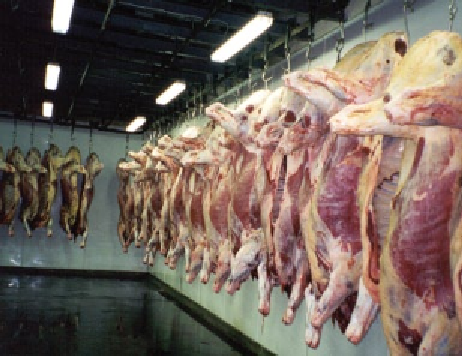Agriculture Reference
In-Depth Information
throughout the chill room (although this depends also
on the evenness of carcase hanging), temperature and
relative humidity. Higher temperatures and air velocities
and low relative humidity increase the weight loss due to
drying out. The Meat Research Institute in Britain
estimated that beef carcases stored in chill rooms can
lose as much as 0.1%/day, while lambs can lose 0.5% in a
relative humidity of 90%. Smaller items of meat lose rela-
tively more because of their relatively larger surface area.
On the other hand, high relative humidity increases
spoilage. A relative humidity of about 90% appears to be
suitable for commercial chilling and for retail purposes.
Air circulation rates
are high in quick-chilling opera-
tions, often 70-110 times the room volume per hour.
The carcase is initially warm and wet but evaporation
from the surface is rapid. In order to minimise loss of
carcase weight while maintaining a short chilling cycle,
high air circulation rates are necessary to lower the
carcase temperature and carcase surface-water vapour
pressure as quickly as possible. Later, when the carcase
temperature has been sufficiently lowered, slower air
circulation rates are more beneficial (Table 4.2).
The Food Safety and Inspection Service of the US
Department of Agriculture advises that for carcase-
chilling coolers, rails should be placed at least 0.6 m from
refrigerating equipment, walls and other fixed parts of
the building and 0.9 m (especially for header and traffic
rails) from walls in order to promote cleanliness and
protect walls from damage. The top of the chill rails
should be at least 3.3 m for beef sides from the floor level,
2.7 m for headless pigs and calves, 2.2 m for beef quarters
and 2 m for sheep and goats (Fig. 4.1).
It is necessary to have several chill units, rather than
one large chill room, with dimensions 18-30 m long
(maximum), 7.6-15 m wide and 4.8 m high (minimum).
Refrigeration requirements for the aforementioned cycle
would be approximately 755-880 kcal/hour per carcase
of 290 kg weight (dry) with about 9.9-11.3 m
3
/min of air
circulated per carcase.
Pork carcases, because of their smaller size, the
presence of a skin and relatively greater fat content,
can tolerate much lower air temperatures and conse-
quently shorter quick-chilling cycles, even as short as
4-7 hours, but most British abattoirs produce pork,
like beef and lamb, during a 24-hour cycle, the carcases
usually being chilled in air at 4°C and at an air speed of
0.5 m/s. Work at the British Meat Research Institute
showed that
ultrarapid chilling of pork
in air at −30°C
and 1 m/s for 4 hours resulted in complete loss of heat
in this short time with a 1% saving in evaporative
weight loss compared with the control carcases han-
dled in the traditional manner. Similar work carried
out under practical conditions on beef carcases in
Australia used initial air temperatures of −15°C and an
air velocity of 3 m/s for 5 hours, resulting in a reduction
of shrinkage from 1.2 to 0.6%.
Table 4.2
Chilled shrinkage of a pig carcase - 60 kg dressed
weight
Air temperature
(°C)
Air speed
(m/s)
Chilling
shrinkage (%)
A
B
Quick chilling
0.5
0.25
1.9
1.5
Rapid chilling
−7
2
1.4
1.0
Source: Cooper, R. (1970) Proceedings of the International
Institute of Refrigeration, Leningrad.
A, 24 hours after slaughter; B, 1 hour after slaughter.
(a)
(b)
Figure 4.1
(a) Pig carcases suspended in a chiller (Reproduced with permission from David Armstrong). (b) Beef carcases suspended by
the 'aitchbone' for chilling (Reproduced with permission from John Hood).













